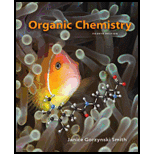
Concept explainers
(a)
Interpretation:
To classify each carbocation as 1°, 2°, or 3°.
Concept introduction:
SN2 reaction is a special type of reaction mechanism in
(b)
Interpretation:
To classify each carbocation as 1°, 2°, or 3°.
Concept introduction:
SN2 reaction is a special type of reaction mechanism in organic chemistry. It is kind of nucleophilic substitution reaction. Nucleophilic substitutions are Lewis acid-base reactions. In this reaction the nucleophile donates its electron pair, the alkyl halide (Lewis acid) accepts it, and the C-X bond is heterolytically cleaved. Alkyl halides are organic molecules that contains a halogen atom X bonded to sp3 hybridized carbon atom. Alkyl halides are classified as primary (1°), secondary (2°), and tertiary (3°) depending on the number of carbons bonded to the carbon with the halogen. In this reaction carbocation cannot form because it is an intermediate formed in the SN1 reaction.
(c)
Interpretation:
To classify each carbocation as 1°, 2°, or 3°.
Concept introduction:
SN2 reaction is a special type of reaction mechanism in organic chemistry. It is kind of nucleophilic substitution reaction. Nucleophilic substitutions are Lewis acid-base reactions. In this reaction the nucleophile donates its electron pair, the alkyl halide (Lewis acid) accepts it, and the C-X bond is heterolytically cleaved. Alkyl halides are organic molecules that contains a halogen atom X bonded to sp3 hybridized carbon atom. Alkyl halides are classified as primary (1°), secondary (2°), and tertiary (3°) depending on the number of carbons bonded to the carbon with the halogen. In this reaction carbocation cannot form because it is an intermediate formed in the SN1 reaction.
(d)
Interpretation:
To classify each carbocation as 1°, 2°, or 3°.
Concept introduction:
SN2 reaction is a special type of reaction mechanism in organic chemistry. It is kind of nucleophilic substitution reaction. Nucleophilic substitutions are Lewis acid-base reactions. In this reaction the nucleophile donates its electron pair, the alkyl halide (Lewis acid) accepts it, and the C-X bond is heterolytically cleaved. Alkyl halides are organic molecules that contains a halogen atom X bonded to sp3 hybridized carbon atom. Alkyl halides are classified as primary (1°), secondary (2°), and tertiary (3°) depending on the number of carbons bonded to the carbon with the halogen. In this reaction carbocation cannot form because it is an intermediate formed in the SN1 reaction.
(e)
Interpretation:
To classify each carbocation as 1°, 2°, or 3°.
Concept introduction:
SN2 reaction is a special type of reaction mechanism in organic chemistry. It is kind of nucleophilic substitution reaction. Nucleophilic substitutions are Lewis acid-base reactions. In this reaction the nucleophile donates its electron pair, the alkyl halide (Lewis acid) accepts it, and the C-X bond is heterolytically cleaved. Alkyl halides are organic molecules that contains a halogen atom X bonded to sp3 hybridized carbon atom. Alkyl halides are classified as primary (1°), secondary (2°), and tertiary (3°) depending on the number of carbons bonded to the carbon with the halogen. In this reaction carbocation cannot form because it is an intermediate formed in the SN1 reaction.
Want to see the full answer?
Check out a sample textbook solution
Chapter 7 Solutions
Organic Chemistry
- A is a toxin produced by the poisonous seaweed Chlorodesmis fastigiata. (a) Label each alkene that exhibits stereoisomerism as E or Z. (b) Draw a stereoisomer of A that has all Z double bonds.arrow_forwardIdentify the starting material in each reaction.arrow_forwardDraw the products of each reaction, including stereoisomers.arrow_forward
 Organic Chemistry: A Guided InquiryChemistryISBN:9780618974122Author:Andrei StraumanisPublisher:Cengage Learning
Organic Chemistry: A Guided InquiryChemistryISBN:9780618974122Author:Andrei StraumanisPublisher:Cengage Learning
